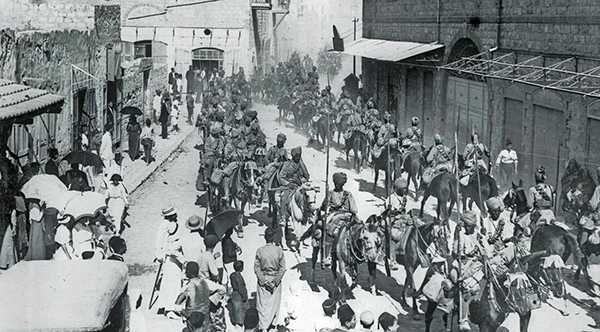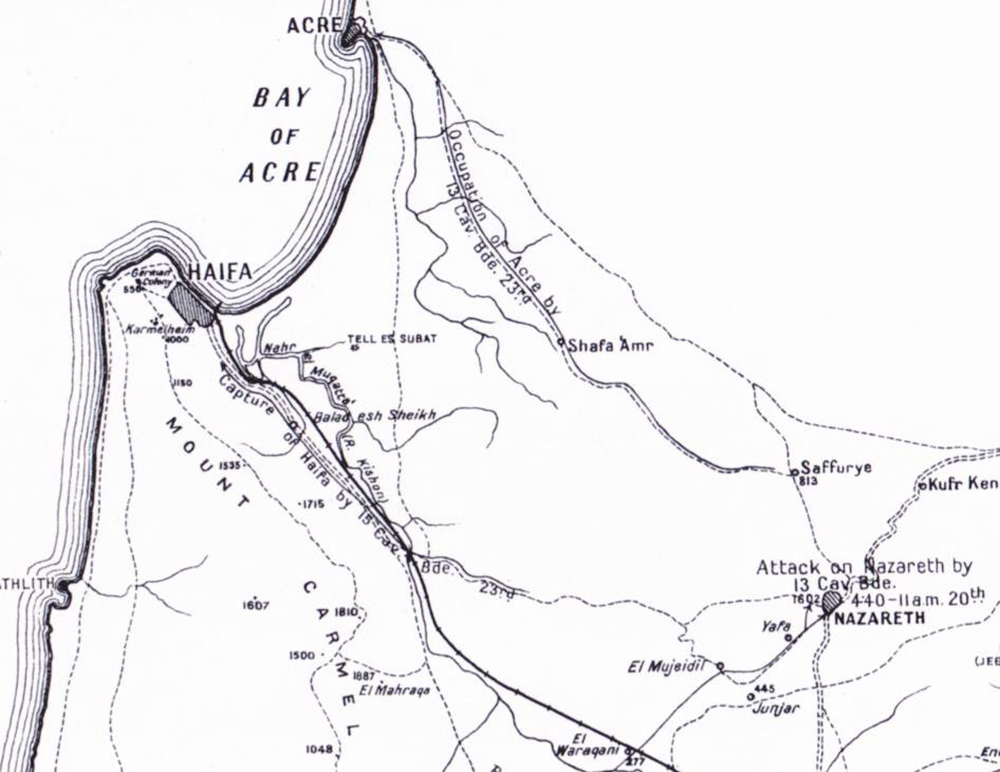The Sinai and Palestine Campaign took place on the Sinai Peninsula, Palestine, and Syria, cities included Gaza, Jerusalem. The battles of the campaign in the Middle Eastern Theatre took place between 28 January 1915 and 28 October 1918. British, Indian, Australian, and New Zealand forces opposed the German and Turkish forces.
Late in 1917, Gen Allenby’s Egyptian Expeditionary Force (EEF) smashed the Ottoman defences and captured Gaza, and then captured Jerusalem just before Christmas.
Gen Allenby launched his long-delayed attack on 19 September 1918. The campaign has been called the Battle of Megiddo. The Turks were taken by surprise when the British attacked Meggido in a sudden storm.
From there it was decided to march off to Damascus. Two separate Allied columns marched towards Damascus. The first approached from Galilee composed of mainly cavalry, both Indian and Australian while the other column travelled along the Hejaz Railway northwards composed of Indian Cavalry and the ad hoc militia following T.E. Lawrence. Australian Light Horse troops marched unopposed into Damascus on 1 October 1918. The war in Palestine was over.
3rd (Lahore) Indian Division and the 7th (Meerut) Indian Division, both pre-war divisions, participated in the Palestine Campaign and as part of the Palestine Occupation Force. The 1st and 2nd Mounted Divisions, both formed in Egypt in 1918 also served with the Palestine Occupation Force before they were broken up in 1920-21.
The 4th and 5th Indian Mounted Divisions were under the Desert Mounted Corps for exploitation.
The 5th Cavalry Division (Desert Mounted Corps) was assigned the task of capturing Haifa and Acre after several earlier attempts were stopped by strong rearguard positions. A squadron of Mysore Lancers, 15th Imperial Service Cavalry Brigade and a squadron of Sherwood Rangers Yeomanry, 14th Cavalry Brigade formed the initial attack on an Austrian artillery battery before moving forward with the Jodhpur Lancers and a light car patrol, to attack the main German rearguard position and capture the town.
On 23 September 1918, the Jodhpur and Mysore Lancers of the 15th Imperial Service Brigade were ordered to capture Haifa.
The Jodhpur Lancers charged the Ottoman position, crossing the Acre railway line, but came under machine gun and artillery fire. The charge was further obstructed by quicksand on the river banks, so they manoeuvred to the left onto the lower slopes of Mount Carmel. The regiment secured the position capturing 30 prisoner, two machine guns, two camel guns and opening up an access route into Haifa. The Jodhpur Lancers continued their charge into the town surprising the defenders. Those Mysore Lancers who had been giving fire support to the attacking regiment, mounted and followed them into the town.
Here is an extract from The Story of the Jodhpur Lancers 1885-1952 by Brig MS Jodha.
“On the night of July 13/14, the Jodhpur Lancers moved from divisional reserve into the portion which included the bridgeheads of Mahadat, Hajla and Henu on the River Jordan, relieving Brigadier-General Godwin’s 10 Cavalry Brigade.
“On 14 July, and ‘A’ Squadron of Jodhpur under Captain Panai Singh and Major Reynolds as SSO, crossed at Henu and another Squadron of Mysore Lancers crossed Hajla bridgehead. In the early hours of the morning ‘A’ Squadron of Jodhpur Lancers, after crossing Sangsters Ford of the Wadi El Rameh, was reconnoitering forward when it made contact with the enemy.
“This squadron of Jodhpur Lancers kept working around the enemy’s flank, but it could not leave the crossings over Wadi El Rameh unguarded. The enemy appeared to be about 300 strong and was shelling the crossings and rear areas with four camel guns (77mm) and two 4.2-inch guns.
“At 1210 hours a combined charge was to be carried out on a given signal. The Jodhpur Lancers charged with 125 men (five troops) and Mysore Lancers charged with six troops (also about 125 men). The Mysore Lancers and Sherwood Rangers advanced, at the same time being ably supported by the two squadrons of the Jodhpur and Hyderabad machine gun section which did great damage to the enemy.
“The advance of the Jodhpur Lancers, less two squadrons, was made in line of troop columns up the Wadi Jorfe. On reaching open ground, deployment was made in echelon in extended troops, and the high ground in front was galloped. On reaching here the two squadrons right shouldered and galloped down the left bank of the Wadi Rameh where they rallied.
“Here the toughest fight took place and many individual fine acts took place and much of the enemy was killed and captured and the machine gun section with the help of Hotchkiss guns did great execution.
“On that day, the Jodhpur Lancers won many honours.
“The enemy retreated hurriedly to their original position in the foothill caves of Wadi Rameh, the Hyderabad Lancers following them up and remaining in touch until 1930 hours when they withdrew into reserve west of the Jordan. Jodhpur Lancers and Mysore Lancers each then kept three squadrons across the river to picket the enemy.”
Together, the two regiments captured 1,350 German and Ottoman prisoners, including two German officers, 35 Ottoman officers, 17 artillery guns and 11 machine guns. Their own casualties amounted to eight dead and 34 wounded. Sixty horses were killed and another 83 wounded.



















